Draft Strategies | Depth Charts | Mock Drafts | SOS | Tools | ADP
Diehards Staff Experts Poll | Draft Simulator | University Videos
2023 Strength Of Schedule How To Maximize Value

Every fantasy manager knows that strength of schedule is important when it comes to gauging fantasy player value, as it is a metric that can help convert a middling fantasy prospect into a solid starter, turn a quality starter into an impact prospect or have the opposite effect in both areas when the schedule is a hindrance. To get maximum value out of this powerful draft factor, let’s do a full analysis of how favorable or unfavorable matchups are likely to impact player value during the 2023 fantasy season.
Methods
The strength of schedule (SOS) rankings are based on several factors, many of which will be covered in the player position sections. These attributes are then weighed and adjusted to a 1-100 scale, with 100 being the most favorable. To make the grades easier to navigate, the numbers have also been color-coded, with low numbers in red, mid-tier numbers in yellow, and high numbers in green. Many fantasy managers subscribe to the idea that early season schedule strength has greater importance because those weeks are less likely to be impacted by the uncertainty that comes with in-season injuries. This mindset resulted in the schedule grades being divided into five sections: Weeks 1-5, Weeks 6-9, Weeks 10-13, Weeks 14-17, and Weeks 1-17. Week 18 is bypassed in the final two sections because most fantasy leagues won’t be active for Week 18.
To highlight how the system works, let’s use the Kansas City quarterback SOS as an example.

In Weeks 1-5, the Chiefs have a 57 score, which signifies that Patrick Mahomes will start the year with a schedule score that is just a bit above average. The outlook for Mahomes is similar throughout much of the rest of the year, as he has SOS scores of 58 and 51 in Weeks 6-9 and Weeks 14-17, respectively, but he has a tougher schedule in Weeks 10-13 due to the 20 score in that span. Put this entire season together and Mahomes ends up with a respectable 57 SOS score.
Best practices for using strength of schedule grades
When reviewing which fantasy players have the best and worst schedules, fantasy managers should keep these three elements in mind: 1. Pay the bulk of your attention to the highest and lowest scores. There is some viable value in comparing players with scores ranging from 25-75, but the optimal approach is to downgrade players with SOS scores lower than 25 and upgrade players with SOS grades of 75 or higher. 2. Consider SOS grades to have a positional impact limit of one tier. There may be a few exceptions to this, but generally speaking, a plus or minus schedule shouldn’t adjust a player’s grade up or down more than one tier. For instance, an RB3 candidate can see his value increase to the RB2 tier if he has a highly favorable SOS grade or can see his value drop to the RB4 tier due to a very negative SOS grade, but SOS scores typically don’t wield enough power to alter that RB3’s rankings to the RB1 or RB5 tier. 3. The primary use of SOS should be as a tiebreaker. Fantasy managers who are reviewing two relatively equal prospects can lean on SOS as a helpful tie-breaking tool to make that pick decision. Before doing so, do note it takes at least a 25-point difference in SOS points to consider this metric an effective tiebreaker. It should be noted that schedule strength grades change during the year, often by a significant margin. To address this, I provide comprehensive season-long strength of schedule updates for my Paydirt Silver and Gold subscribers. These adjustments help fantasy managers adjust their in-season roster strategies based in part on the changing schedule landscape. Now let’s review how SOS grades impact the five primary fantasy football positions.
Quarterbacks
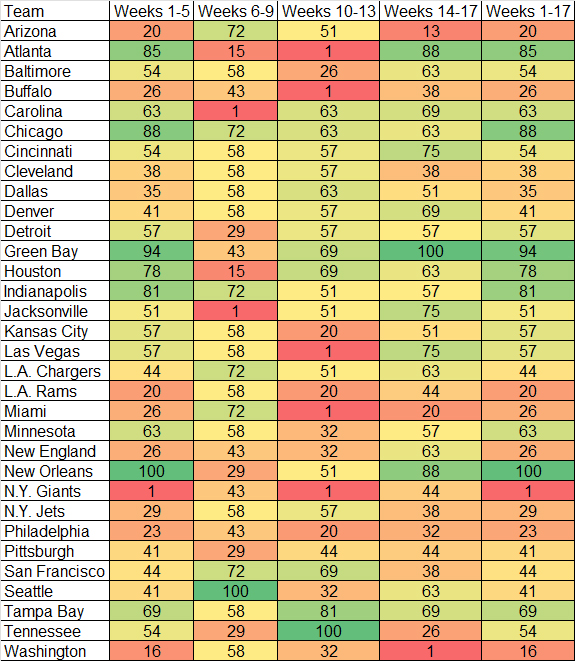
Highlights
Derek Carr has only been a QB1 once in his career, ranking 10th in 2016, but the schedule may give him a shot at returning to that level in 2023, as the Saints’ field general has the most favorable schedule overall and the top schedule in Weeks 1-5. Atlanta and Green Bay have superb bookend scores with upper-tier rankings in Weeks 1-5 and Weeks 14-17. That leads to two of the top scores in this category and suggests that Desmond Ridder and Jordan Love could have hidden value as depth QBs, but be aware that the Falcons also have a very unfavorable schedule in between those peaks. Justin Fields has an 88 overall SOS score, and his schedule segment scores never drop below 63, so he has a schedule consistency that is rare among upper tier QB1 candidates.
Lowlights
Daniel Jones has the lowest matchup points total among quarterbacks for the season, but what makes that even worse is that he also has the lowest score in Weeks 1-5 and Weeks 10-13. Add it up and it’s a reason to potentially avoid him as a low-tier QB1 candidate. Kyler Murray doesn’t weigh in quite as badly as Jones in this category, but his 20 SOS points mark is tied for third lowest among quarterbacks for the entire season, and he has 20 and 13 scores, respectively, in Weeks 1-5 and Weeks 14-17.
Fireworks points
One additional metric used to grade fantasy quarterbacks is fireworks points. This statistic gauges the likelihood that a team will get into a larger than average volume of high-scoring games (defined as contests where each team scores 24-plus points). This metric is utilized in grading every fantasy football player, but it has a greater impact on quarterback grades due to their principal role in high scoring games. The Chiefs are the only team with a perfect 100 score in this category headed into the 2023 season. It’s just another reason to justify ranking Patrick Mahomes at the top of the QB charts. Six teams are tied for second here with an 89 score, a list that includes Chicago, Dallas, Denver, San Francisco, Seattle, and Washington. That potential production spike adds value to Justin Fields, Dak Prescott, Russell Wilson, and Geno Smith as possible start candidates and helps Trey Lance, Brock Purdy, or Sam Howell as depth candidates. New Orleans and Atlanta bring up the rear in this metric with a 1 score in fireworks points, which is a factor in downgrading Derek Carr or Desmond Ridder. Jacksonville and Tennessee claim the other two spots in the bottom four, which hurts the cases of Trevor Lawrence, Ryan Tannehill or Will Levis.
Running Backs

Highlights
The 100 matchup points that the Chicago Bears have in rush defense SOS score for the season should vault Justin Fields’ ranking at the quarterback position and will also assist Khalil Herbert, D’Onta Foreman, and Roschon Johnson to varying extents. Image RB Four other teams claim a 90-plus score in rush defense matchup points: Detroit and Minnesota (both with 95 points) along with Denver and Green Bay (92 points). This increases the upside potential for Jahmyr Gibbs, David Montgomery, Javonte Williams, Alexander Mattison, Aaron Jones and AJ Dillon. Every NFC North team also has fairly favorable rush defense SOS score throughout the season segments, so these running backs have positive schedule consistency cases as well. Closing out the notable schedule boosts here are Carolina (86 points) and New Orleans (81 points). These much better than average marks make Miles Sanders a potential RB2 upside play and indicates sneaky upside potential for Alvin Kamara and Jamaal Williams.
Lowlights
There are six teams with a season-long rush defense SOS total below 20. Cincinnati rates last, as the Bengals have an overall rush defense SOS score of 1 and no score above 50 in any of the weekly sections. Cleveland and Miami are tied for second lowest with a score of 7. The Browns have an up and down schedule, with a 1 SOS score in Weeks 1-5 and a 22 score in Weeks 10-13, but the Browns do close the year with an SOS 82 score, so there is a silver lining. Miami’s schedule is a slalom, as it starts with a 58 score and continually gets lower, closing out with a 15 score in Weeks 14-17. This indicates fantasy managers may want to reconsider relying on Dolphins RBs as depth candidates. Houston, Indianapolis, and Seattle close out the sub-20 scorers in this category.
Other items of note
Bijan Robinson heads into training camp as a potential top-5 RB candidate and Atlanta starts the year with a 100 SOS rush defense score in Weeks 1-5, so the opening schedule adds to Robinson’s RB1 case. Derrick Henry also has a great starting score, with an 86 mark in Weeks 1-5, and the Titans have a 100 score in Weeks 14-17, but their 1 score in Weeks 6-9 is a middle of the season concern.
Wide Receivers
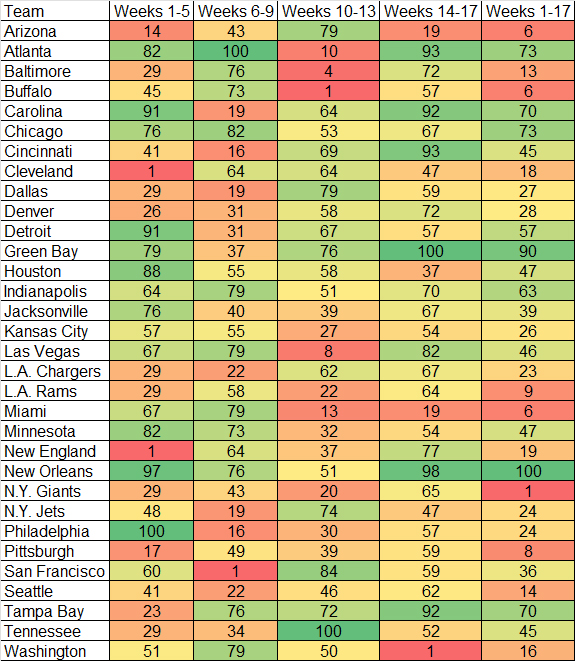
Highlights
Derek Carr isn’t the only Saints’ passing game player to benefit from a favorable pass coverage schedule, as the New Orleans’ wide receiving corps has a 100 score for the entire 2023 campaign, as well as a 97 score in Weeks 1-5 and a 98 score in Weeks 14-17. It may be tough to trust Green Bay pass catchers with the unproven Jordan Love under center, but fantasy managers can take solace in knowing that the Packers’ wideouts have a 90 pass coverage SOS score. That may make Christian Watson or Romeo Doubs viable upside plays at various points of fantasy drafts. WR image Philadelphia, Carolina, and Detroit wide receivers can be added to list of early season upside plays, as they have SOS scores of 91 or higher in Weeks 1-5. The Panthers also have a 92 score in Weeks 14-17, something that may make Adam Thielen and DJ Chark good fantasy playoff starters.
Lowlights
The Giants’ wide receiving corps won’t be drawing much attention during fantasy drafts for many reasons, and fantasy managers can also add an unfavorable schedule to that list, as New York sports a 1 score in this season-long measure of this category. Five other teams come into this season with a single-digit SOS ranking in wide receiver coverage, as Arizona, Buffalo, and Miami have a 6 score here, while Pittsburgh has an 8 score and the Rams have a 9 score. There are plenty of quality wideouts on those clubs, including Stefon Diggs, Cooper Kupp, Tyreek Hill, and Diontae Johnson, but every one of those players will likely lose a SOS tie-breaking battle with a similarly rated wide receiver on draft day.
Other items of note
Fantasy managers aiming for SOS consistency at this position may want to look at Tampa Bay’s pass catchers, as the Bucs have 72-plus SOS scores for three of the four season segments and have a 70 overall score in this category. It’s the type of thing that can make Mike Evans and Chris Godwin good roster picks even with the downgrade at quarterback from Tom Brady to Baker Mayfield.
Tight Ends
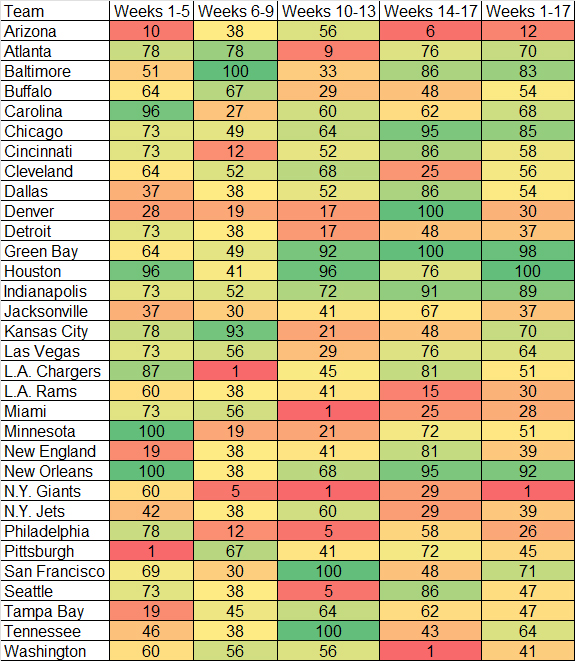
Highlights
Green Bay, Houston, and New Orleans are the three teams with 90-plus season long SOS scores for tight ends, but the reality is that Dalton Schultz is likely to be the only fantasy tight end roster addition among that group to benefit from this, as he is the sole starter-caliber candidate among tight ends on those squads. For those looking to use this metric as a tiebreaker among the upper-tier tight ends, note that Travis Kelce (70) and Mark Andrews (83) have very similar scores, while T.J. Hockenson (51) falls a step behind them in this category.
Lowlights
Only two tight ends come into the 2023 campaign with an SOS score of lower than 20. Darren Waller is the primary concern here, as he may be the most talented pass catcher on the Giants’ roster, but he has a 1 SOS score and thus is going to be challenged to compete with the second tier TE1 contenders. Zach Ertz is the other TE with an SOS score of less than 20, and when that is added to what is likely to be a split target situation with Trey McBride, it makes it tough to suggest drafting Ertz.
Other items of note
TE images There is a plus for Hockenson, as he has a 100 SOS score in Weeks 1-5, so fantasy managers looking for an early season TE scoring spike may want to add draft day value to Hockenson.
Defense/special teams
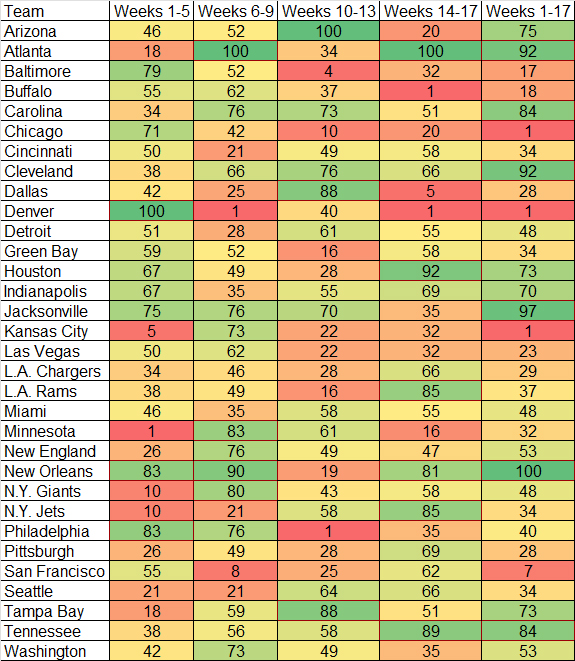
There are three elements that make up the D/ST SOS rankings: Pass blocking points. This metric reviews which teams have the best/worst pass blocking schedules. This highlights value very effectively because sacks usually account for more than 50 percent of overall D/ST value. Pass rushing talents generate much of that sack value, but an abundance or lack of pass blocking skill can be even more important, which is why this metric has primary value in the D/ST SOS measurement. Interception points. There are gunslingers and game managers at the quarterback position, and the gunslingers are the ones who are more likely to throw interceptions. This metric measures the risk-taking levels of those opposing passers to help determine how likely it is that a D/ST will compile a large number of interceptions. D/ST fireworks points. This is the flip side of the offensive fireworks points measurement, as it improves D/ST value when the matchups are against opponents with low-powered offenses and lowers D/ST value in contests against high-powered offenses.
Highlights
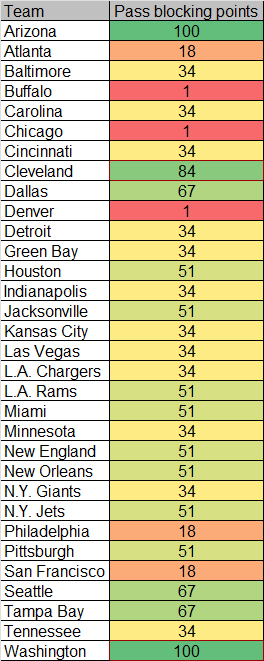
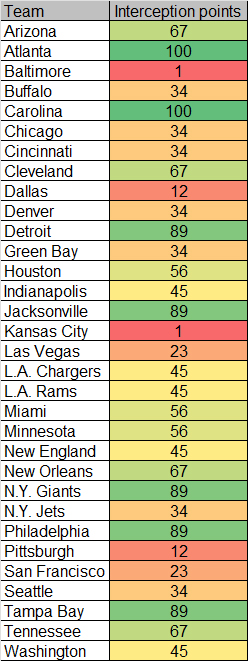
DEF image Team pass blocking pints mage Team int points image The Saints’ D/ST is a winner here on two levels, as New Orleans has the best D/ST SOS score for the 2023 season and has 81 scores in three of the four weekly sections. The Saints will generally be considered a borderline D/ST1 in most draft rooms, but this hugely favorable schedule slate makes New Orleans a potential late-round upside value pick. Arizona and Washington both have the league lead in terms of favorable pass blocking matchups, as the Cardinals and Commanders each have 100 scores in this metric. Cleveland is the only other club to tally an 80-plus score here, as the Browns registered an 84 pass-blocking points score. Atlanta and Carolina get the most assistance from the interception points category, as they lead the league with 100 scores there, but five clubs (Detroit, Jacksonville, NY Giants, Philadelphia, and Tampa Bay) aren’t far behind with 89 scores. The Falcons also get a boost from the D/ST fireworks points category, being tied with New Orleans for the top spot at 100 points and is part of why Atlanta ended up with a 92 overall D/ST SOS score. The Falcons aren’t a draftable D/ST for a variety of reasons, but they should be on the early season watch list as a club that could be a quality D/ST spot starter. team fireworks points image team fireworks points
image 2
Lowlights
[D-ST Fire Points [OFF Fire Points][
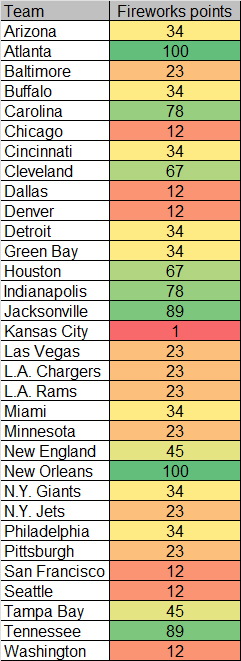
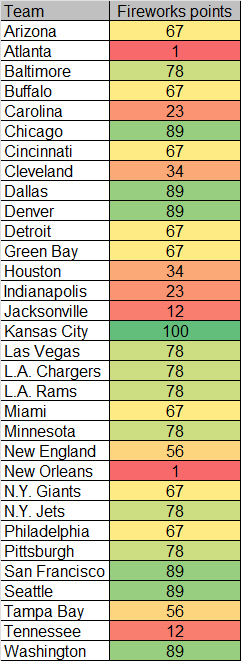
The San Francisco 49ers have one of the strongest cases for the top D/ST spot, but the schedule points total isn’t an element leaning in that direction, as the 49ers have a 7 D/ST SOS score. The two other D/STs with starter-caliber ratings that suffer in the D/ST SOS metric are Denver and Kansas City, as they are tied for last place here with a score of 1. Denver also has a 1 score in D/ST SOS in Weeks 6-9 and Weeks 14-17, so the Broncos are a tough sell as a consistent point scorer at this position. Part of Denver’s schedule woes come in the pass blocking points category, as the Broncos are tied with Buffalo for last there with a 1 score. Kansas City’s bottom of the barrel ranking in SOS points is due in part to a 1 score in interception points, as the Chiefs are tied with Baltimore for last in that metric. The Chiefs also suffer from placing last in D/ST fireworks points, as no other club ranks as low as Kansas City in that category. It’s tough to see that changing since the Chiefs D/ST plays opposite a Kansas City offense that might be the highest-powered platoon in the NFL. Check out Paydirt! The subscription service from football analytics pioneer KC Joyner. Find out more at http://thefootballscientist.com. Follow KC on Twitter @KCJoynerTFS.
